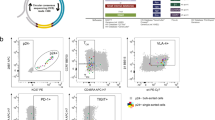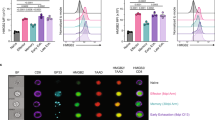Abstract
DURING intrathymic T-cell ontogenesis, functionally competent CD3+CD4+CD8− and CD3+CD4−CD8+ T lymphocytes develop from immature CD4−CD8− thymocytes after transiently acquiring a double-positive CD4+CD8+ phenotype1–3. The partition between CD4+CD8+ and CD4−CD8+ T cells is generally considered to be irreversible, although a small percentage of circulating CD3+ T lymphocytes coexpressing CD4 and CD8 molecules has been identified4. It has been suggested that in CD8+ T cells the CD4 genes may be methylated and thus highly repressed5, whereas in CD4+ T cells the CDS genes are unmethylated6 and their transcription can be induced by physiological stimuli such as interleukin-4 (ref. 7). Here, we demonstrate that infection with human herpesvirus 6 (HHV-6) (ref. 8), a virus proposed as a potential cofactor in AIDS (ref. 9), dramatically upregulates the expression of CD4— the receptor for human immunodeficiency virus type-1 (HIV-1) (refs 10–12)—in a human neoplastic T-cell line. More importantly, HHV-6 induces de novo expression of CD4 messenger RNA and protein in normal mature CD8+ T lymphocytes, rendering them susceptible to infection with HIV-1. These findings demonstrate that human CD3+CD4−CD8+ T lymphocytes can reacquire CD4 in the post-thymic life and elucidate a novel mechanism—receptor regulation—through which HHV-6 may positively interact with HIV-1 in coinfected patients.
This is a preview of subscription content, access via your institution
Access options
Subscribe to this journal
Receive 51 print issues and online access
$199.00 per year
only $3.90 per issue
Buy this article
- Purchase on Springer Link
- Instant access to full article PDF
Prices may be subject to local taxes which are calculated during checkout
Similar content being viewed by others
References
Reinherz, E. L. & Schlossman, S. F. Cell 19, 821–827 (1980).
Scollay, R., Bartlett, P. & Shortman, K. Immun. Rev. 89, 79–95 (1984).
von Boehmer, H. et al. A. Rev. Immun. 6, 309–328 (1988).
Blue, M. L., Daley, J. F., Levine, H. & Schlossman, S. F. J. Immun. 134, 2281–2286 (1985).
Richardson, B., Kahn, L., Lovett, E. J. & Hudson, J. J. Immun. 137, 35–39 (1986).
Carbone, A. M., Marrack, P. & Kappler, J. W. Science 242, 1174–1176 (1988).
Paliard, X., de Waal Malefijt, R., de Vries, J. E. & Spits, H. Nature 335, 642–644 (1988).
Salahuddin, S. Z. et al. Science 234, 596–601 (1986).
Lusso, P. et al. Nature 337, 370–373 (1989).
Dalgleish, A. G. et al. Nature 312, 763–767 (1984).
Klatzman, D. et al. Nature 312, 767–768 (1984).
McDougal, J. S. et al. Science 231, 382–385 (1986).
Solbach, W. J. exp. Med. 156, 1250–1263 (1982).
Stinski, M. F. J. Virol. 23, 751–767 (1977).
Balachandran, N., Amelse, R. E., Zhou, W. W. & Chang, C. K. J. Virol. 63, 2835–2840 (1989).
Rice, G. P. A., Schrier, R. D. & Oldstone, M. B. A. Proc. natn. Acad. Sci. U.S.A. 81, 6134–6138 (1984).
Lusso, P. et al. J. exp. Med. 167, 1659–1670 (1988).
Blue, M. L., Daley, J. F., Levine, H., Craig, K. A. & Schlossman, S. F. J. Immun. 137, 1202–1207 (1986).
Pagano, J. S., Kenney, S., Markovitz, D. & Kamine, J. J. Virol. Meth. 21, 229–239 (1988).
Shearer, G. M. et al. J. clin. Invest. 76, 1699–1704 (1985).
Gerstoft, J., Dickmeiss, E. & Methiesen, L. Scand. J. Immun. 22, 463–469 (1985).
Sharma, B. & Gupta, S. Clin. exp. Immun. 62, 296–303 (1985).
Bach, M.-A. et al. J. Immun. 132, 735–740 (1984).
Sattentau, Q. J., Dalgleish, A. G., Weiss, R. A. & Beverley, P. C. L. Science 234, 1120–1123 (1986).
Moretta, A., Pantaleo, G., Moretta, L., Cerottini, J. C. & Mingari, M. C. J. exp. Med. 157, 743–751 (1983).
Wilkinson, M. Nucleic Acid Res. 16, 10933 (1988).
Biassoni, R., Ferrini, S., Prigione, I., Moretta, A. & Long, E. O. J. Immun. 140, 1685–1690 (1988).
Feinberg, A. P. & Vogelstein, S. Ann. Biochem. 132, 6–12 (1983).
Maddon, P. J. et al. Cell 42, 93–104 (1985).
Psallidopoulos, H. C. et al. J. Virol. 63, 4626–4633 (1989).
Author information
Authors and Affiliations
Rights and permissions
About this article
Cite this article
Lusso, P., De Maria, A., Malnati, M. et al. Induction of CD4 and susceptibility to HIV-1 infection in human CD8+ T lymphocytes by human herpesvirus 6. Nature 349, 533–535 (1991). https://doi.org/10.1038/349533a0
Received:
Accepted:
Issue Date:
DOI: https://doi.org/10.1038/349533a0
This article is cited by
-
Role of Immunological Testing in Infertility
Current Obstetrics and Gynecology Reports (2024)
-
Clonal expansion of CD4+CD8+ T cells in an adult patient with Mycoplasma pneumoniae-associated Erythema multiforme majus
Allergy, Asthma & Clinical Immunology (2021)
-
HHV-6B infection, T-cell reconstitution, and graft-vs-host disease after hematopoietic stem cell transplantation
Bone Marrow Transplantation (2018)
-
Roseolovirus-associated encephalitis in immunocompetent and immunocompromised individuals
Journal of NeuroVirology (2017)
-
Classification of HHV-6A and HHV-6B as distinct viruses
Archives of Virology (2014)
Comments
By submitting a comment you agree to abide by our Terms and Community Guidelines. If you find something abusive or that does not comply with our terms or guidelines please flag it as inappropriate.



